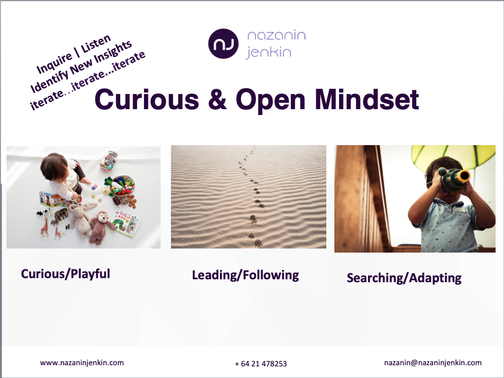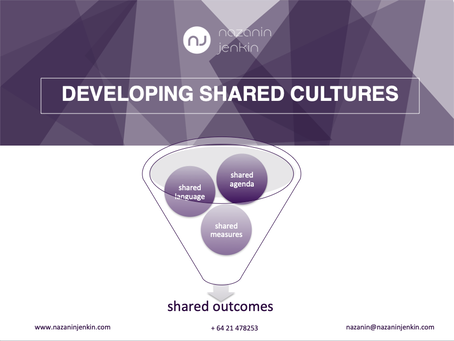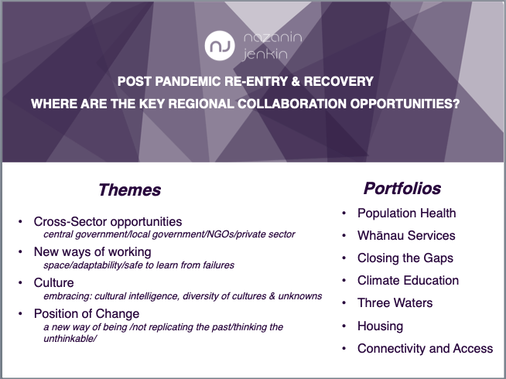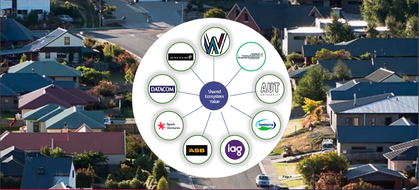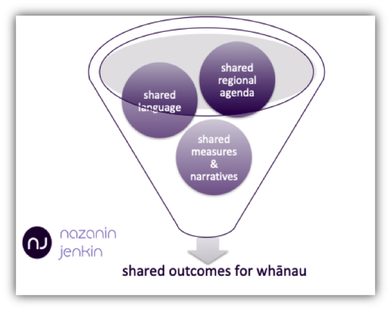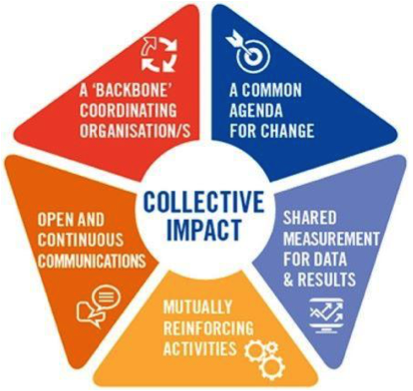I'm thinking about... |
|
Over the last four weeks, we have offered some of our collaboration insights for regions and local communities in Aotearoa New Zealand. In the first three articles in this series, we built the case for ‘why’ collaboration is critical for regional impact; ‘how’ collaboration has led to success in a New Zealand regional context (with two case studies); then we expanded on the “Art of Collaboration”, with six key themes to support leaders in Aotearoa. In this, our final post, we explore the “Benefits of Collaboration”, with an ongoing focus on Regional Impact. The value of collaboration – regional, team, cross-organisation, cross-sector, across the supply chain or other - is built on the premise that we are #betterworkingtogether. And, that to #buildbackbetter in a post-COVID environment, responding to the wicked and complex problems facing us nationally and globally requires “everyone and everything” – the variety of resources, people, disciplines and skills. When we ask people to share of their most positive collaboration experiences, we find their responses are often deeply personal and rooted in high-trust relationships. Participants in our workshops said: - Collaboration leads to connection with people. You feel like you’re on a mission together. However, because collaboration is not a linear process, nor a direct cause and effect relationship - evidencing the benefits has proven to be challenging. Whilst there is a growing interest in collaboration as an approach and methodology, there is still an accompanied rhetoric that collaboration can be “problematic, very difficult or hard”. So we find leaders continue to ask:
We know that an ongoing focus on quantitative analysis with siloed KPIs and outcomes has limitations in this arena. The benefits of collaboration are more evident when we take a “shared measures” approach. Additionally, we have to consider how we can turn positive experiences and oft “intangibles” into “tangibles” by using potential “proxy” measures that better reflect the benefits of the collaboration journey. Most importantly, we need to consider wider social and community benefits through alternative evaluation and assessment approaches such as qualitative analysis and stories. We can identify changes in behaviour and circumstances better, when told by the beneficiaries of the specific collaborative initiative. Talking a business perspective, the Institute for Collaborative Working (ICW) in partnership with Warwick University research “Benefits Realisation from Collaborative Working” found tangible benefits of collaboration included:
- The value of collaboration is mutual benefit. - The value has been in being able to have a different level, more strategic conversations with our customers, but also the fact that it’s created a framework for our teams and our more junior staff members to work to. So there’s a common way of working across the business now. So that’s a value that’s directly attributable to collaborative working. Taking a team collaboration perspective Deloitte’s “The Collaborative Economy” report showed benefits included: · Improved Time-saving and Productivity of Employees · Improved Quality of Work Output · Improved Innovation and New Ideas Generation · Improved Employee Engagement and Reduced Turnover · Increased Growth · Increased Profitability The report showed that, “Companies that prioritise collaboration are also five times more likely to experience a considerable increase in employment, twice as likely to be profitable, and twice as likely to outgrow competitors.” and “...businesses that consider collaboration an important component of their overall business strategy were four times more likely to see growth in their bottom line.” In our work and research we have shown that taking a collaborative approach, within a structured framework (you can’t “wing it” or just work with intuition!) delivers three key benefits: 1. Improved Innovation Bringing together the variety of voices of all those that have “skin in the game” - diverse personalities, disciplines and expertise - improves momentum and supports problem solving. Safe, open spaces encourage open communication and help create a dialogue that finds solutions faster and enables untapped opportunities come to life. Sometimes, bringing together different perspectives creates friction, but this friction often sparks new, dynamic ideas. Working in an environment of mutual respect, we embrace “healthy conflict” and support the emergence of new ideas. In our experience, whatever the outcome, when all the voices have been heard – everyone is more comfortable and able to embrace the final decision and approach. With reduced duplication, streamlined shared processes and back office system support and shared transparent shared risks, it is easy to see how everything comes together to increase profitability for individual organisations and the whole region. Together, partners are able to support regional community wellbeing across the spectrum: social, economic, cultural and environmental. Working collaboratively to drive innovation together supports timely and ongoing communication; encourages a collective line-of-sight on the opportunities; helps us adapt to change; and, holds the collaboration space across all contributors and partners, irrespective of external pressures. 2. Improved Cultures: leading to Improved Performance and Wellbeing The ICW report challenged us “to change traditional organisational cultures to more readily accept collaborative business models”. They said, “This highlights the need to identify and further develop competencies and skills to harness collaborative working. There is a clear recognition that the adoption of a more systematic approach...integrated with supportive collaborative processes and systems will underpin the business environment where collaborative working can be seen as a competitive advantage.” In our experience, whatever the outcome, when all the voices have been heard – everyone is more comfortable and able to embrace the final decision and approach. With reduced duplication, streamlined shared processes and back office system support and shared transparent shared risks, it is easy to see how everything comes together to increase profitability for individual organisations and the whole region. Everyone has been part of a team or complex programme of work where everything breaks down due to poor or untimely communication. Understanding the impact of our efforts in light of the whole, coupled with the communication skills and wider collaboration behaviourial set, we are able to integrate efforts and changes into the programme to ensure the right outcomes. Collaboration tends to make people feel more connected to each other and therefore more motivated to work together towards a common goal. It fosters a sense of collective purpose, with a meaningful reason to work together and achieve better results as part of a “team”. Agreeing collaboration as a regional strategy creates a values-based culture, driven by “collaboration” and “collaborative behaviours” as the accepted norm. 3. Collective Impact This in turn drives an ecosystem approach across individual contributors and portfolio leads. It becomes possible to see the connections across the system more transparently. Complex governance mechanisms, disconnected regional strategies, undergirded by red-tape bureaucracies are unhelpful; so we need to foster high-trust relationships that dominate the culture of working together in our communities and regions.It’s only when we take an “ecosystem” approach that real change is possible and we are able to focus on optimising the collective impact of individual efforts, across the regional disciplines and portfolios (e.g. housing, infrastructure, three waters, community connectedness, social sector initiatives etc.) to deliver shared value and collective impact The opportunities for #workingbettertogether in New Zealand are endless, and to truly #buildbackbetter, we need each other to build “our” collaborative muscle. All this requires courageous leaders that embrace collaboration - not just as a competitive advantage, but rather an existential advantage for their business, region and community in these disruptive times.
If you are on a strategic collaboration and partnership journey – do get in touch, let’s talk. We’d welcome the opportunity to serve you in your context. No silver bullets, just proven and tested frameworks and approaches. Until next time, kei runga noa atu. He waka eke noa
0 Comments
In this series of articles we have built the case for “why” collaboration is critical for regional impact (and indeed in other areas too), how collaboration has led to success in a New Zealand regional context and made a difference for business, regions and communities. In this third article we expand on the “Art of Collaboration” to support leaders in Aotearoa. Collaboration is a stand-alone process that requires a specific skill set and behaviours. When done well we observe improved innovation and faster response to market conditions faster. Organisations with collaborative cultures experience higher levels of employee satisfaction and, as a result, productivity. Yet, unfortunately despite best intentions, too often we fall short of the promise of collaboration. “The challenge is that building and managing successful cross-sector partnerships is really hard. In fact, a recent Hilton Foundation study found that fully 75 precent of cross-sector partnerships fail to meet partner expectations. Clearly, if cross-sector collaboration is going to fulfil its potential in solving the challenges of the 21st century, organisations—large and small—need to do a better job of it. While scholars such as Michael Porter and Howard Buffett have brilliantly articulated why working across sectors is so important, there is a lack of practical information, tools, and insights on how to build and manage cross-sector collaboration.” In considering the “Art of Collaboration”, here are some of our top tips for helping your collaborations be more beneficial and successful. We hope you find these useful. 1. Collaborate with a Shared Purpose/Agenda Before starting it’s critical to agree your “why”. Not all situations are suited to collaboration, so it’s important to agree that “collaboration” is the strategic approach that will support the desired outcomes and steer us towards a solution. All those involved need to agree why they are together and work collectively to develop an agreed shared purpose or agenda. This takes investment of time and energy up front, before we start working together. The challenge and opportunity is ensuring all are prepared to invest this time and effort, which requires leadership sponsorship. The value created through this work is often difficult to quantify and only apparent further down the road. 2. Take a Strengths-Based Approach Agreeing and understanding our why helps us identify who to invite to the partnership. Everyone has a role and responsibility – there are no ”passengers” on the journey. Real collaboration relies on an understanding that, collectively, we are better than when we’re working alone. True collaborative magic starts occurring when you identify what people are good at; you can set them up for success by pairing roles and responsibilities that suit their strengths. Collaboration makes possible futures we cannot achieve alone; it makes complex problems - from inequality to climate change - more possible to address. 3. Build Trust Relationships High trust relationships are fundamental to getting together and delivering collaboration successful. Working to a shared purpose, taking a strength-based approach we found that “competitive” behaviours reduced and a rapid increase in the level of trust within the group. You must be conscious where you are introducing competitive tensions or hints of competitive tensions. In “The Neuroscience of Trust”, [NJ1] the authors suggest some useful behaviours to foster trust:
4. Agree Shared Outcomes/Goals, Incentives and Measures To work together effectively, we need to define the key missions of impact - this helps align everyone right from the start and leads to more effective collaboration through your journey together. Maintain a visual focus and reminder by adding the shared outcomes/goals to your daily management tools so people remember what is to be done and what’s at stake. Ensure all partners have the mandate and are empowered to deliver against their agreed individual roles and responsibilities. Share resources equitably and support collective progress. Build organic mentoring relationships through trusted relationships that ensure individual and corporate capability is developed throughout the journey. Use common tools and methods, towards developing a shared language that crosses sectors and disciplines and is understood by all in the joint venture. Take time to agree what success will look like and how each partner will be supported in delivering towards that vision. Be open to reviewing and revising this vision if the context and wider environment changes. We recommend, you use a variety of tools and techniques that integrate numbers (KPIs), stories and visual representations. Taking a shared approach to outcomes, incentives and measures reduces duplication and waste, supports consistency across the partnership, helps with comparability of information and allows us to build a shared understanding of what works and why. It’s then easier to identify what needs to change, why and when. And, taking a shared approach will lead to closer collaboration and enables a process of working out the solution in an agile, adaptive way, together. All this needs to be undergirded by collaborative governance structures and independent backbone capability for the collaborative venture. 5. Build Rituals and Rhythms that are Context and Culturally Sensitive Sustaining a collaborative venture can be tough. In complex system environments there are very few areas that we can control – one that we can control is our rituals, so being intentional about them becomes important for the wellbeing of the partnership effort. Build your own Customs or Tikanga to start and end each meeting, and agree how you will work together – some guidelines, policies or “kawa” that you are all agreed on will be needed. Take time to pause and welcome everyone at the beginning of each session together. For example, in New Zealand, starting our gatherings with a karakia or a blessing for the joint collaboration and whakawhanaungatanga are important. “Whakawhanaungatanga” is literally translated as the process of “establishing relationships, relating to others” or metaphorically it is about connecting at both a physical and spiritual level. The process of whakawhanaungatanga is designed to create kinship and connection and build trust, which are all fundamental to collaboration. We often use the Māori pipeha as a form of introduction – this indigenous approach establishes identity and heritage and our places of origin, which reminds us of our individual humanity and collective connectedness. Whakawhanaungatanga humanises the experience of collaboration whilst building trust, connection and empathy for others. “Ka mua, Ka Muri - Walking backwards into the future” Take to time to share stories and build an understanding of all partners’ histories. One of the insights that we learned very early in our various collaborations was that taking the time to understand the stories of the people and places brings deeper connections and understanding of what matters. Ultimately, the rituals and rhythms need to be context and culturally sensitive, built on an understanding of place and origin. 6. Collaborative Leadership Collaborative leaders support safe, open spaces where diverse perspectives can be heard. In our experience and backed by the research, diversity and inclusion boosts innovation and financial results – delivering better outcomes. Part of what makes people, organisations, regions and communities so interesting is the fact that we are all different. These differences when harnessed and channelled appropriately, can lead to insight and opportunity not previously seen. "Diverse and inclusive cultures are providing companies with a competitive edge over their peers.” This quote summaries conclusions from The Wall Street Journal’s first corporate ranking that examined diversity and inclusion among S&P 500 companies. The Journal’s researchers’ work joins an ever-growing list of studies by economists, demographers, and research firms confirming that socially diverse groups are more innovative and productive than homogeneous groups.” In a regional context, a diverse membership in your collaboration, that has cross-sector reach and involves key stakeholder groups, is highly recommended. The best type of collaborations included public sector, private sector, NGO, Iwi and local community stakeholders (e.g. educational organisations, regional economic development agencies etc.). In “Better Connected Services for Kiwis”, writing in a public sector context, the authors identified three clear leadership roles in any collaboration venture:
In our experience, collaborative leaders provide top-down commitment and create bottom-up engagement through empowering leaders across the system. They are authentic and model servant leadership. More often than not we see the “entrepreneurs” rise as the first movers and shakers towards a collaborative venture. Passionate advocates who see a different way of working, one that harnesses a wider set of resources than is visible or available to a non-collaborative way of thinking. We observe it is their courage and tenacity that brings the support across the system and together they drive a new collaborative movement. I believe that collaborative initiatives shouldn't be pilots, they should be corporate initiatives. These efforts can certainly take time but if the organisation makes the decision that collaboration is the direction they want to go down then that’s it. No giving up and no turning back. Moving forward, organisations cannot succeed without connecting their employees and their information. Making collaboration work isn’t an option it’s THE option. In our next and final article, we will explore the benefits of collaboration before wrapping the four-part series up. The opportunities are endless – localised responses across the regions of Aotearoa are a great place to start.
If you are on a strategic collaboration and partnership journey – do get in touch, let’s talk – we’d welcome the opportunity to serve you in your context. No silver bullets, just proven and tested frameworks and approaches. Until next time, kei runga noa atu. He waka eke noa. #collaboration #buildbackbetter # workingbettertogether In our first article of this series, we built the case for “why” collaboration is critical for regional impact (and indeed in other areas too) and offered some definitions of collaboration for consideration. In this second article, we continue to develop these ideas and build on the “how” and “what” of collaboration, by considering two collaboration success stories in a New Zealand regional context. The goal of creative collaboration is to explore unknown directions and to develop new possibilities. It’s not about knowing the answers – it’s about learning through exploration and experimentation. We didn’t start with the answers. Through the processes of collaboration in quite different contexts, partners were able to identify common agendas and work together to find collective solutions. In these examples, we demonstrate both internal and external collaboration, as well as complex cross-sector and system collaboration successes. Common threads across these successful programmes of work include: ●An investment of time at the beginning of the journey to agree why we are collaborating – this means we are working to an agreed shared agenda (which has some fluidity and can adapt through the process). ●A strengths–based approach across all partners. We each acknowledge that the effort required is beyond any one of us, we identify each partner’s contribution and value-add to the whole (we move beyond competing for the same space). ● Throughout, we are utilising frameworks and approaches in an organic way, artfully mixed and adapted to meet the needs of the context and changing dynamics. ●Recognising that collaboration is a stand-alone skill set and capability; there is committed investment in building the collaboration muscle. ● We have created open environments where sharing ideas and discourse of ideas is safe and all the voices are heard. ●Collaborative Leadership: there is a focus on empowering leaders across the organisations. The focus and reliance on hierarchies and titles is taking a back seat, as thought leaders emerge and are enabled. ●There is a readiness to move beyond individual partner foci to a system-wide collective focus. We have incredible opportunity to act collectively for impact in areas we care about, In the face of challenge people do amazing things. What follows below are two collaboration success stories in a New Zealand regional context, which we have had the privilege of being part of. We highlight these to illustrate how collaboration has made a difference for these businesses, regions and communities and how collaboration might benefit you and your organisation. Innovation Neighbourhoods |
Nazanin jenkinNazanin Jenkin Archives
September 2021
Categories
All
|


